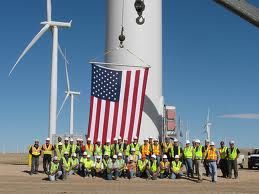It’s been a big couple of weeks for global wind energy, with generation records notched up in the UK – where wind farms produced 22 per cent cent of the country’s electricity on Sunday, beating the 24hr record for the second time in a week – and in our own Western Australia (25% on a week day); as well as a big prediction from Bloomberg, that the world would add an average of 50-53 gigawatts of new onshore wind energy capacity a year out to 2020.
But perhaps the biggest news has come from the US, where a new report from the Department of Energy and Lawrence Berkeley National Laboratory found that the price of wind energy for new power purchase agreements signed in 2013 hit an all-time low of 2.5 cents per kilowatt-hour, or $US25 per MWh.
That’s below the low-end price at which gas can be delivered at in the US. Or, as Greentech Media’s Eric Wesoff put it so eloquently on Monday, that’s cheap power!
The 2013 Annual Wind Technologies Market Report found that, despite the year being a “modest” one for US wind energy growth – only 1,087 MW of new capacity was added and $1.8 billion invested, America still ranked second in the world for installed wind power capacity, around 4.5 per cent of total US electricity demand, and the future looked bright.
At the end of March this year, there was already 13,000MW of wind power capacity under construction in the US, enough to power more than 3 million homes, with plans submitted for another 114GW. And the report predicts US wind farms can generate 20 per cent of US electricity by 2030.

Wind power now contributes more than 4 percent of the nation’s electricity supply, more than 12 percent of total electricity generation in nine states, and more than 25 percent in two states, according to the report. Texas continues to lead in installed capacity, with more than 12GW, while California, Iowa, Illinois, Oregon and Oklahoma all have more than 3GW.
But it is the record low price of US wind power that has really captured our attention – and perhaps put paid to arguments like that recently trotted out by Queensland National Senator Matt Canavan, that windmills have been around for centuries and “are still not economically viable.
So it’s worth looking at some of the reasons why wind energy has become so cheap in the US – an outcome that, as one of the report’s authors, Berkeley Lab Staff Scientist Ryan Wiser, described as “especially notable because, enabled by technology advancements, wind projects have increasingly been built in lower-wind-speed areas.”
One of the biggest factors is the nation’s strong and growing domestic supply chain industry. As the report notes, “despite challenges, a growing percentage of the equipment used in US wind power projects has been sourced domestically since 2006-2007.”
The data shows that the combined import share of wind equipment inclluding blades, towers, generators, gearboxes, and wind-powered generating sets, is estimated to have declined from nearly 80 per cent in 2006-2007 to approximately 30 per cent in 2012–2013.
And despite industry growing pains – “more domestic wind manufacturing facilities closed in 2013 than opened,” says the report – the profitability of US turbine suppliers rebounded in 2013, after a number of years in decline. The report says that five of the 10 turbine suppliers with the largest share of the US market had one or more domestic manufacturing facilities at the end of 2013, as opposed to just one, nine years earlier.
The report also notes that wind turbine prices themselves have fallen 20 per cent to 40 percent from their peak in 2008, a cost saving that is driving project costs down. Installed costs averaged $1,630 per kilowatt last year, down more than $600 per kilowatt from the apparent peak in 2009.
And turbine scaling, including increased rotor diameters, is improving wind project performance; enabling wind project developers to build projects economically on lower-wind-speed sites. Projects in high-wind-resource regions are seeing a boost in capacity factors because of improved turbine performance.
It is also interesting to note that independent power producers own 95 per cent of the new US wind capacity installed in 2013, according to the report, which notes that – on a cumulative basis, considering all wind installed by the end of 2013 – independent power producers (IPPs) own 83 per cent of wind power capacity, while utilities own 15 per cent, with the final 2 per cent owned by other entities, like councils, schools or commercial customers.
Long-term contracted sales to utilities remained the most common off-take arrangements – either owning (4%) or buying (70%) power from 74% of the new capacity installed in 2013 – but the report noted that merchant projects could be regaining favor, at least in Texas.
And finally, there is the policy. While the US is not free from renewables policy uncertainty, it has not been of the magnitude we have seen here in Australia.
As the report notes, “the availability of federal incentives for wind projects built in the near term has helped restart the domestic market … and are expected to spur capacity additions in 2014 and 2015.”
And while the main federal wind subsidy has now expired, its renewal still uncertain, the report notes that “the prospective impacts EPA’s proposal regulations to reduce carbon emissions from existing and new power plants may create new markets for wind energy.”








